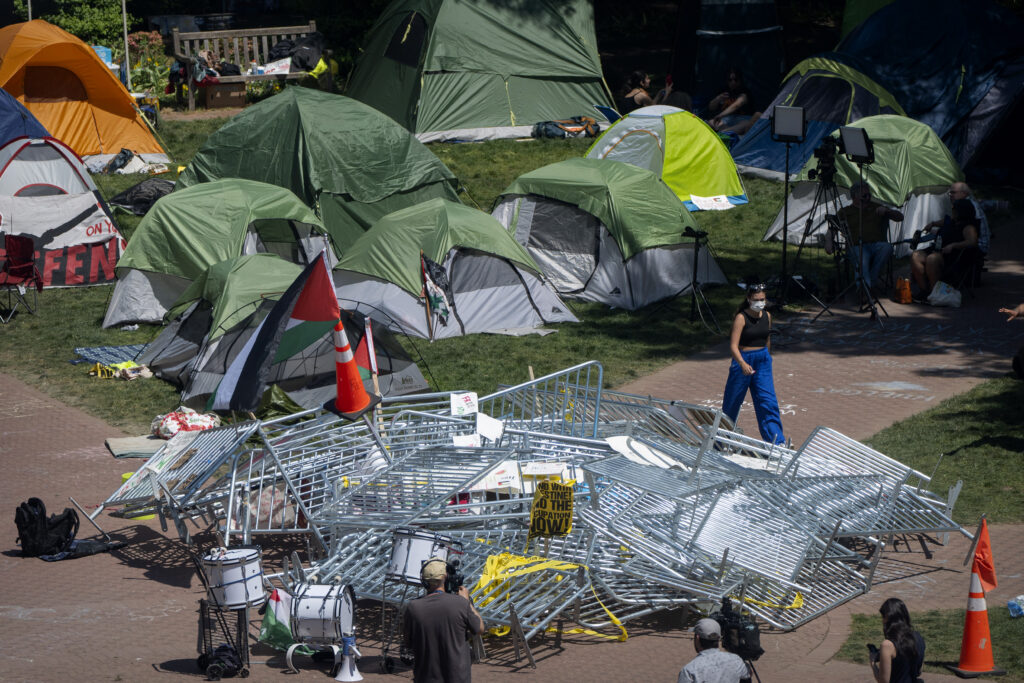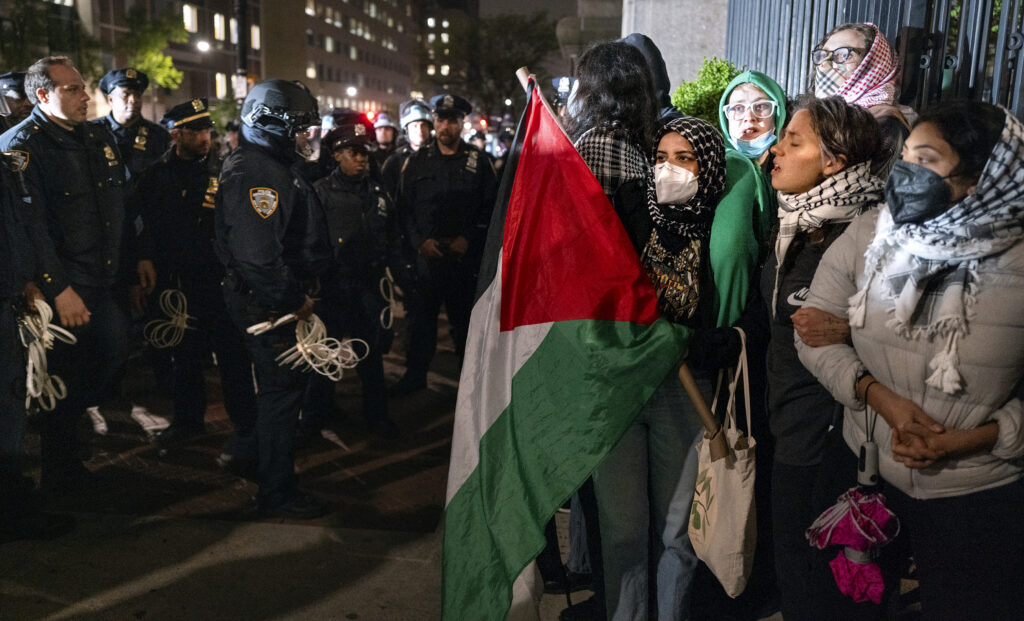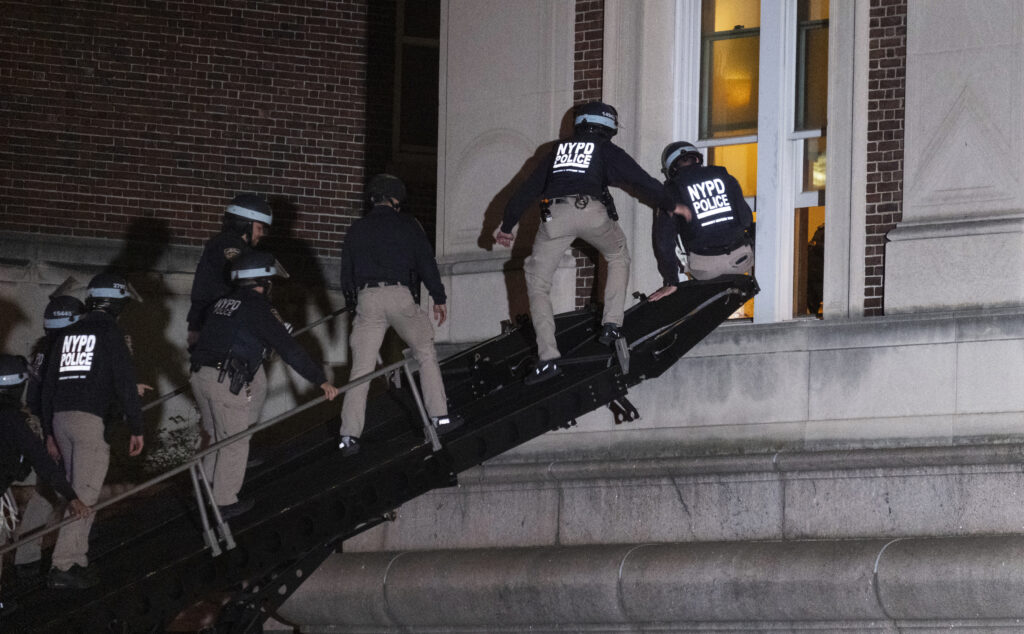As Kent State University prepares to commemorate the 54th anniversary of the shooting of anti-Vietnam War protesters on its campus, universities are struggling with how to respond to present-day pro-Palestinian agitators protesting the Israel-Hamas war.
The May 4, 1970, crackdown on anti-war protesters by the Ohio National Guard weighs heavily on the minds of school administrators today who, until very recently, have largely allowed illegal encampments to disrupt students without much pushback.
“I think every administrator, even if they weren’t alive then, is aware of that, and they are worried about a situation escalating beyond their control,” Robert Shibley, special counsel for campus advocacy at the Foundation for Individual Rights and Expression, told the Washington Examiner. “I think that does make them reluctant to use police to remove people who are breaking the rules or even hesitating to use them when protesters are blocking legitimate students from getting to places or even in situations of violence.”
While Columbia University finally allowed the New York City Police Department to take back control of its campus after weeks of blocking them, other schools have instituted half-measures or even capitulated to the demands of protesters.
At George Washington University, a fence was built around the encampment, meant to keep new protesters from entering but allowing those remaining to leave. While the encampment dwindled to around 20, students promptly clashed with university police, broke through the barriers, and expanded their encampment both in size and in personnel. Washington, D.C.’s Metropolitan Police Department refuses to answer university calls to help clear the illegal encampments.

Rutgers University, University of Minnesota, Northwestern University, and Brown University have each capitulated to many of the protesters’ demands, which have also seen encampments cleared.
In conservative states like Texas, the approach has been different, with protesters at the University of Texas clashing with school police, supported by Texas Department of Public Safety officers.
With the Saturday anniversary of Kent State, coupled with the stratification of responses from schools, particularly those involving heavy police presence, many are drawing parallels.
What happened at Kent State?
Protests at Kent State began May 1, 1970, in response to President Richard Nixon’s announcement that U.S. troops would invade Cambodia as part of the war in Vietnam.
Many of the protesters were unarmed but violent and openly noncompliant with police and National Guard attempts to keep the peace.
On the night of May 1 and into the early hours of May 2, protesters set fire to dumpsters in the streets, clashed with the police responding, and began breaking store windows when police tried to clear the streets. By May 2, after a civil emergency was declared by the mayor, protesters set fire to the ROTC building on campus, completely destroying it, and cheered while it burned. Protesters attempted to thwart firefighter attempts to extinguish the blaze by slashing fire hoses, causing another clash with authorities.

Despite the fact that announcements were made that demonstrations would be prohibited on campus, thousands of students showed up May 4 and were told to disburse by the National Guard. Protesters were met with bayonetted M1 Garand rifle-wielding guard members and tear gas. Some protesters began throwing rocks at the authorities, and guard members began shooting. While some shot into the air, others shot into the crowd, resulting in the casualties. It is disputed whether the guard members were shooting in self-defense, as has been claimed by some.
On May 4, 2024, Kent State plans to “honor and remember” the incident.
Roseann “Chic” Canfora, the chairwoman of the commemoration organizing committee and whose brother was injured, said, “Our challenge as planners of May 4 commemorations the last 54 years has been, not only to find appropriate ways to remember the students who died and those who were injured that day, but also to find ways to make May 4 meaningful for current students today.”
Canfora said college students are the “conscience of America,” adding, “It’s on college campuses where students daily dream and plan for a future for themselves and for others. … Students have historically been at the forefront of change.”
Kent State and the modern response to protest
To many observers, school responses to the protests, some of which have been characterized by disrupting students from getting to class, harassment, and even intimidation, have been lackluster. Republicans across the board have called for a heavy police presence to effectively bulldoze encampments, which are unauthorized, while Democrats and school administrators have been walking a tighter rope between faithfully keeping the peace on campus, for which they are fully responsible, and allowing the protesters to remain.
The reluctance to use police force to maintain safety and enforce school rules is fueled by at least two things, Shibley said: the specter of Kent State and the political alignment of the administrators with the protesters.
“Kent State is both a reason and also to some extent an excuse to say, ‘Oh, we can’t send the police in. What if things get violent?’” Shibley said. Administrators making that argument assume a police presence will inherently become violent and are therefore more easily able to justify their inaction.

Recently, Sen. Tim Kaine (D-VA) made the comparison explicit, saying, “I think calling in the National Guard to college campuses for so many people would recall what happened when that was done during the Vietnam War, and it didn’t end well. The National Guard going to college campuses, Kent State and elsewhere, did not end well.”
Even if administrators are worried about clashes becoming violent, much of the complacency from schools is motivated by viewpoint discrimination, Shibley said, where by and large, school administrators see the pro-Palestinian protesters as in their political camp. They are therefore willing to slow-walk a response to keep the peace, move the goalposts for breaking the rules, and even negotiate and capitulate to the demands of protesters.
“When colleges allow people to break the rules because they’re afraid to take action against their favored political sides, they are courting this disaster,” Shibley said. “It’s impossible to imagine, for example, Colombia going through this level of negotiation if the occupation were from the people who were marching in Charlottesville. Americans understand, and students understand too, that they can’t count on being treated the same regardless of who they are or what they believe, and that’s corrupt and it’s wrong, and it leads to dangerous situations like we’re seeing on campuses now.”

“Colleges have really lost a lot of credibility over the last generation because it’s become very clear that if you happen to be among the college’s political favorites, they are not going to enforce the rules the same strict way that they might with people they disfavor,” he continued. “If you start making exceptions for them, it’s reasonable that the people who are benefiting from those exceptions will continue to try to push the boundaries of what they’re allowed to do.”
CLICK HERE TO READ MORE FROM THE WASHINGTON EXAMINER
Regardless of the hypocrisy in dealing with unrest on campus, large-scale clashes with authorities have been made almost inevitable by schools not taking early action to enforce their own rules, which increases the risk of injury for protesters, bystanders, and police, Shibley explained.
“The correct approach to that is to not let it get to that situation in the first place,” he said. “If you’ve abdicated your responsibility to ensure that the rules are followed early on, it’s true that the risks are higher for something like that later on when things are already out of control. But you’re still responsible for making those decisions.”
